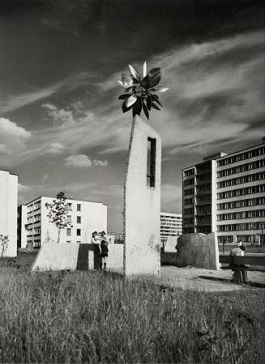
The exhibition showcases images of Prague's housing estates from the time of their creation
 |
A significant part of the photographer's estate includes professional works, extensive compilations of negatives, contact prints, and author enlargements of architecture from the 1960s to the 1980s, housing complexes, and individual buildings.
The author’s archive also contains documentation of sculptures in public spaces, a collection of works by Eva Kmentová, Valerián Karoušek, Ladislav Kovařík, Miloš Zeto, Miloslav Chlupáč, mobile sculptures by Jiří Novák, and other sculptors. They are captured shortly after installation, many of which no longer exist today. Public sculpture from the second half of the 20th century is currently of interest to researchers and art historians, especially the younger generation.
According to the exhibition organizers, the most popular work of Voženílek became the simple photograph Winter in Prague from 1960, depicting human bustle on the snow-covered slopes of Petřín.
“He always carefully composed the shot so that the 'socialist' architecture, hastily constructed, looked good, and thus often the photographs greatly outperformed the shabby and mundane reality. Perhaps this made my father happy at least in the eyes of his architect friends, who during the totalitarian era and prefabrication could hardly afford anything,” said architect Alice Čermáková about her father's photographs. She dedicated a collection of Voženílek's photographs to the Museum of Applied Arts, which also operates the Josef Sudek Gallery.
Zdeněk Voženílek was born on January 23, 1929. In his youth, he acted in amateur theater, engaged in visual arts, and aspired to be a cameraman. However, he studied at a construction vocational school. He achieved higher professionalism later, in 1961 and 1962, during studies at the People's Academy of Science, Technology, and Art, where he focused on the aesthetics and technique of black-and-white photography.
In the late 1950s, he gained employment at the Prague Project Institute. He initially worked in the studio of architect Josef Fuchs, co-author of the Trade Fair Palace, and later with Richard Podzemný. He died in Prague in 1981 at the age of just 52.
The English translation is powered by AI tool. Switch to Czech to view the original text source.
0 comments
add comment






